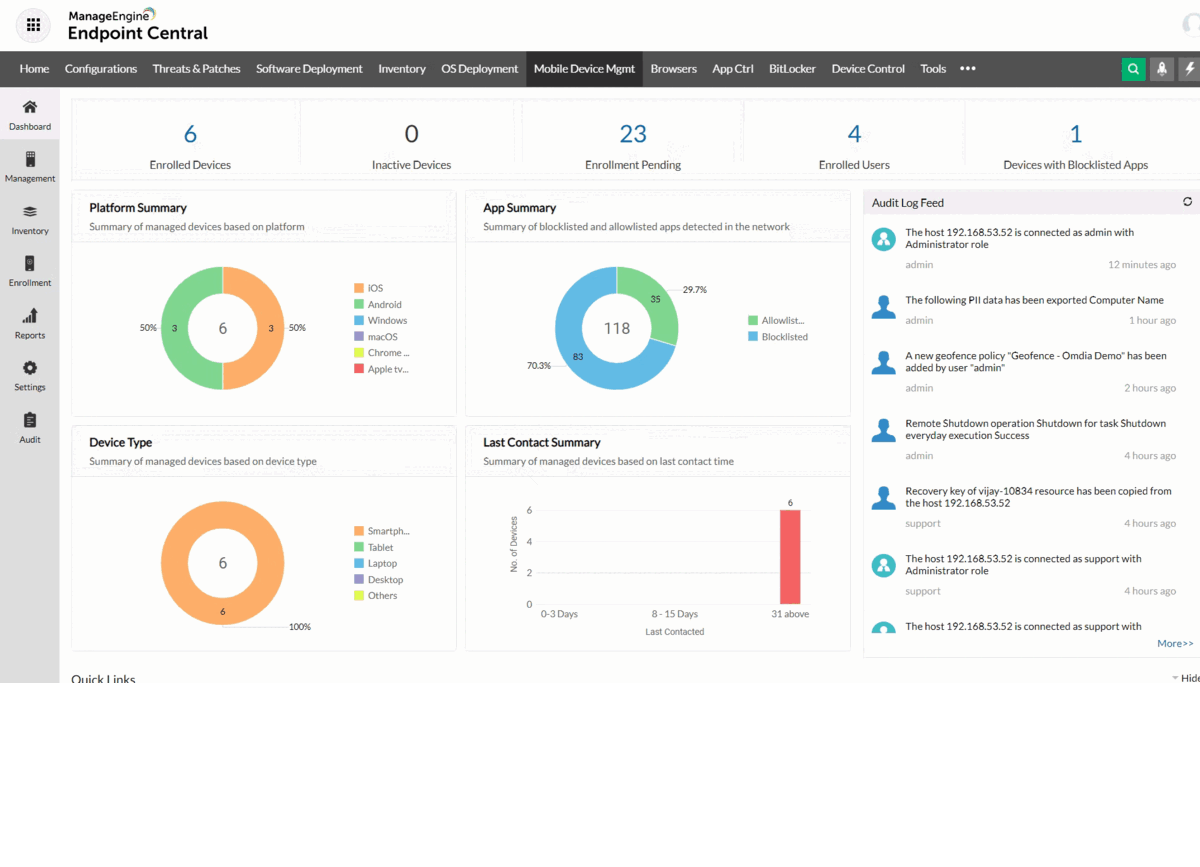Managing IT assets goes beyond just keeping tabs on them.
Feeling overwhelmed by the growing list of IT assets at your small business? From keeping tabs on those high-end laptops your remote team uses to managing software licenses, IT asset management (ITAM) could be the answer. But as a leader, it's crucial to determine if your business genuinely needs a full-blown ITAM solution or if you're just aiming to organize your devices for better cost management.
ITAM isn't just about tracking assets—it's a comprehensive approach that demands time, budget, and attention. While the right tools can streamline the process, the legalities around asset compliance might have you thinking about teaming up with an IT services provider. To give you more perspective, our 2023 IT Management Survey* offers insights into how peer SMBs are handling their IT assets.
Types of IT assets and their lifecycle
IT assets comprise all the tools and resources your business uses daily, from the laptop you're typing on to the software that manages your employees’ attendance. Think of them as the backbone of your digital operations.
IT assets can be divided into two categories:
Hardware: Tangible tech items you can touch. Think computers, servers, printers, and Wi-Fi routers.
Software: Intangible items you can’t touch but can only interact with. Your laptop’s Windows or Mac operating system, installed applications, and any cloud-based services you use.
Before learning about the management of IT assets, it’s important to understand the IT asset lifecycle.

In Capterra's IT Management Survey*, our analysts asked 500 small-business IT leaders about the total number of IT hardware assets they own. The average response was around 300, which clearly highlights the importance of understanding IT asset management.
What is ITAM (IT asset management), and who does it?
IT asset management, also known as IT inventory or hardware asset management, is the process of evaluating the cost, maintenance, and lifecycles of IT assets. Your company's IT asset procurement manager or inventory manager does this in three steps to increase the business productivity value of these IT assets.
Step 1: Achieve comprehensive asset visibility
They start by conducting a hardware inventory audit, which is essentially a thorough check of all the physical IT equipment your business owns. This helps them create a detailed inventory of all IT assets, ensuring each item is accounted for and optimizing any redundant or underused assets for better efficiency.
In your small business, this could mean listing out all the laptops, servers, and printers, ensuring none are gathering dust in a storeroom.

Step 2: Ensure financial and legal compliance
Once everything's listed, your IT manager will use IT asset management software to keep an eye on each asset. Beyond just tracking its location or performance, they're also vigilant about its financial cost (both the original purchase price and ongoing maintenance costs), warranties, licenses, and service-level agreements (SLAs).
/ Note
An integral part of this monitoring is ensuring compliance. This means making certain that all software licenses are valid, and the company isn't using more copies than they've purchased. Non-compliance can lead to hefty fines and legal complications.
For a creative design startup agency, this could involve ensuring Adobe Creative Suite licenses are up to date. If they're using more licenses than they've bought, they risk facing penalties from software providers. So, it's not just about asset performance—it's also about staying on the right side of the law and avoiding unnecessary costs.
Step 3: Optimize asset performance and longevity
As each IT asset goes through its life, there are times when it'll need a bit of maintenance and attention. This could be repairs, upgrades, or even replacements. Every action taken on an asset is logged. This isn't just for record-keeping; it helps in assessing how well an asset is doing and informs future purchasing decisions.
If a software developer’s high-performance PC starts slowing down, it might be upgraded with more Random Access Memory (RAM) or replaced entirely, and this decision would be based on its logged performance history.
Do all businesses need to manage their IT assets?
While every business should be aware of its IT assets, not all need a formal IT asset management process. Larger companies with vast IT resources definitely benefit from structured ITAM. However, for a smaller outfit, say a startup with fewer than 30 devices, a full-blown ITAM might be overkill. Instead, they could consider using simpler solutions such as basic inventory and digital asset management tools to keep tabs on their tech.
Benefits of IT asset management using the right resource
Our survey* shows that among all available tools for managing IT assets, IT leaders most prefer IT asset management software for its tangible benefits.

1. Simplifies compliance and software license management

Managing software licenses and ensuring compliance are critical tasks of software asset management for any business. As mentioned above, non-compliance can lead to hefty fines and even legal issues. ITAM software comes to the rescue with features such as automated license tracking.
This allows an asset procurement manager to easily monitor the number of licenses in use, their expiration dates, and whether the company is adhering to the terms. The result? A streamlined process that keeps you on the right side of the law.
2. Enhances cybersecurity and risk management

Cybersecurity is not just a buzzword; it's a necessity. ITAM software helps in this arena by providing a centralized inventory of all IT assets, both hardware and software. Knowing what you have and its location is the first line of defense.
Asset procurement managers can use ITAM software to identify outdated software or hardware that may be vulnerable, allowing for timely updates or replacements. This proactive approach significantly reduces security risks.
3. Increases asset utilization efficiency

Having IT assets that are underutilized or, worse, sitting idle, is like leaving money on the table. ITAM software helps asset procurement managers get the most out of each asset. With features like real-time tracking and performance metrics, managers can easily identify which assets are being used to their full potential and which ones need to be reallocated or optimized. The end result is a more efficient use of resources, saving both time and money.
4. Improves decision-making regarding IT investments

Making informed IT investment decisions can be the difference between business growth and stagnation. ITAM software provides asset procurement managers with comprehensive data on the performance, usage, and lifecycle stages of each IT asset. This data-driven approach allows for more accurate forecasting and budgeting.
When it's time to upgrade or invest in new technology, managers can make choices based on solid evidence rather than gut feeling, ensuring that every dollar spent is a step toward achieving business goals.
5. Improves asset tracking and visibility
Knowing where your IT assets are and how they're being used is crucial for any business. Without this visibility, you're essentially flying blind. ITAM software offers features such as real-time asset tracking and detailed reporting.
For asset procurement managers, this means a clear, up-to-date picture of the entire IT landscape. Whether it's locating a missing laptop or understanding the usage patterns of a specific software, ITAM software provides the insights needed for effective management.
How are the concepts of ITAM and ITSM related?
ITAM (IT Asset Management) and ITSM (IT Service Management) are closely related but serve different functions. ITAM is a subset of ITSM, focusing solely on managing IT assets throughout their lifecycle. On the other hand, ITSM encompasses a broader range of activities, including incident management and service delivery.
While asset procurement managers typically handle ITAM tasks, such as license compliance and hardware asset inventory, IT service managers oversee ITSM activities such as help desk support. Both aim to optimize IT operations but from different angles.
Be mindful of these IT asset management challenges
Managing IT assets comes with some unexpected challenges. It’s important to know them before they leave a notable dent in your operations.
1. Unplanned asset procurement
Small-business owners often make ad-hoc IT purchases to meet immediate project requirements or to take advantage of a sale without considering a long-term strategy. This can lead to a mismatch between assets and actual needs, resulting in wasted resources such as unused software licenses or redundant hardware such as extra laptops.
To tackle this, asset procurement managers can use predictive analytics software to forecast future needs, such as the requirement for high-performance workstations for an upcoming graphic-intensive project. This enables them to make data-driven procurement decisions, such as bulk purchasing software licenses at a discounted rate for anticipated team growth.
2. Inconsistent software versioning
Businesses often end up with multiple versions of the same software due to staggered update schedules or legacy systems that can't support newer versions. This creates compatibility issues, affecting project timelines and productivity. For example, inconsistencies such as different Microsoft Office versions can lead to formatting errors in shared documents.
Asset procurement managers can resolve this by using the ITAM tool to flag such inconsistencies and automate updates. Ensuring all systems are on the same software version eliminates these compatibility issues, allowing for smoother collaboration and workflow.
3. Overlooked software license renewals
Missing a software license renewal can lead to operational hiccups such as software lockouts, disrupting employee tasks, or even loss of access to critical asset data. Even legal consequences could arise, such as hefty fines for using unlicensed software. This challenge is amplified in small businesses where asset procurement managers often juggle multiple roles, such as procurement, inventory management, and even basic IT support.
Implementing automated reminders within your ITAM software can help you stay on top of renewals. When automating reminders, set multiple alerts at different intervals, such as 30, 15, and seven days before the renewal date, to ensure it doesn't get overlooked.
4. Insufficient staff training
Lack of IT asset training can lead to improper usage, such as employees downloading unauthorized software, which can expose the system to security risks. This reduces asset lifespan by causing unnecessary wear and tear on hardware components and increases asset maintenance costs for tasks such as virus removal.
Asset procurement managers should arrange for regular training sessions on best practices for asset usage. They can use employee training software, which offers features such as interactive tutorials and progress tracking, to ensure staff are well-versed in how to properly use and maintain IT assets.

Mobile device management aka IT asset management software helps with several tasks from managing software compliance to detecting asset vulnerabilities (Source)
Managing IT assets is a breeze with the right team
According to our survey*, nearly four out of every five small-business IT managers use a blend of an internal IT team and an external IT service provider to manage their company's IT.

Even with the right tools and software, managing IT assets can be a daunting task for small businesses. It's not just about keeping track of what you own; it's also about catching hidden costs, staying updated on compliance regulations, maximizing asset lifecycle, and careful asset disposition to prevent data loss or environmental harm.
That's where IT service agencies come into play. They do more than just deploy software; they take the burden off your shoulders. From tackling legal compliances to timely asset upgrades and software updates, these agencies have you covered. They'll even assign an expert asset manager to audit and manage your physical assets, offering consultation to ensure you're prepared for surprise audits from government bodies, thus safeguarding your business reputation from unanticipated penalties.
To give you a head start, Capterra offers a verified directory of IT service agencies. Reach out to them and make managing IT assets a job well done. And, if you feel overwhelmed with the long list of agencies or ITAM software, download Capterra's software and vendor comparison template for free by filling out the form below.

